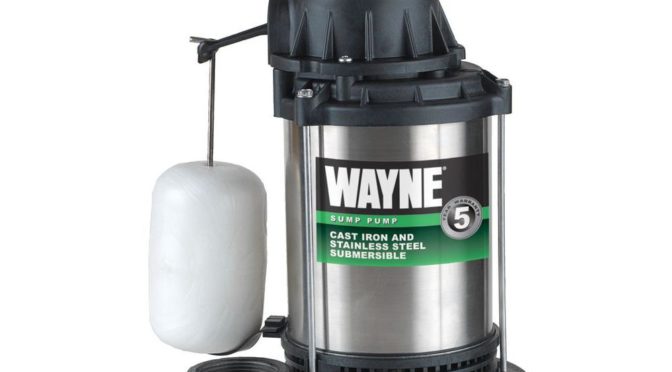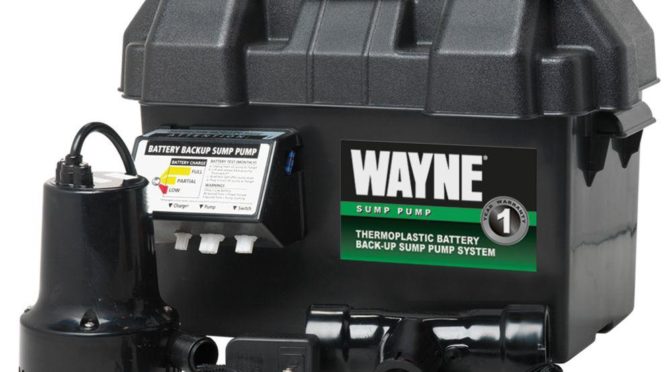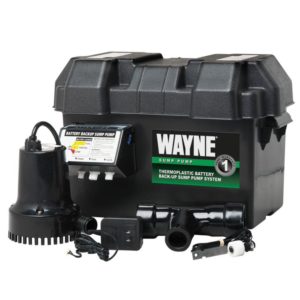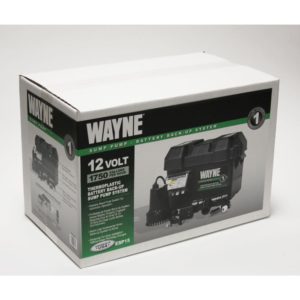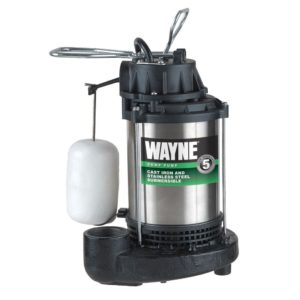 We always recommend spending a bit more than the $100-$150 prices you’ll find for budget box store sump pumps if you can help it. We’ve seen too many of these pumps fail after the six month to one year window (typically just after the warranties expire), and you don’t want to spend any more time in a sump pit (or pay a plumber to do so) than necessary. Rather than throwing good money after bad, we’re of the mind that it’s better for your time, money, and sanity to just get things done correctly the first time; there are a lot of sump pumps on the market that will give you years of service while keeping your basement dry.
We always recommend spending a bit more than the $100-$150 prices you’ll find for budget box store sump pumps if you can help it. We’ve seen too many of these pumps fail after the six month to one year window (typically just after the warranties expire), and you don’t want to spend any more time in a sump pit (or pay a plumber to do so) than necessary. Rather than throwing good money after bad, we’re of the mind that it’s better for your time, money, and sanity to just get things done correctly the first time; there are a lot of sump pumps on the market that will give you years of service while keeping your basement dry.
If you’re looking for a sump pump to last for as long as you own your house, we always first recommend the Zoeller M267. It pumps water faster than any other AC sump pump under around $500 and it’s also one of the most reliable (we’ve seen models with 20 years of daily service still working). However, if you can’t spend the $300 necessary to bring one home, we’d recommend pumps like the Zoeller M63 or Zoeller M57 first (we struggle to recommend the Zoeller M98 due to reliability issues). Another good option, however, especially if you need high flow rates, is the Wayne CDU1000 Submersible Sump Pump. It’s the fastest sump pump under $200 that runs on AC power. We like it; read on to find out why.
Key Features of the Wayne CDU1000 Sump Pump (60 Second Summary)
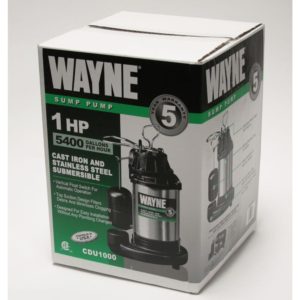 The Wayne CDU1000 sump pump is an automatic submersible sump pump. It is powered by a 1 HP motor and can pump up to 5,400 gallons per hour and features a 5 year limited warranty. It is 14 inches tall, 10 inches wide, and 14 inches deep. It can pump water at up to 22 feet vertically with switch-on/switch-off heights at 4 and 9 inches respectively. It features a vertical float switch and uses 9.8 amps and 120 volts; no battery backup is included. We weighed it at 22 pounds on our scale and it includes an 8 foot power cord. The max pump rate is 5,400 GPH at 0 feet but the discharge flow drops to 3,960 GPH at 10 feet, 2,940 GPH at 15 feet, and 1,560 GPH at 20 feet. It is designed to operate between 33 and 120 degrees Fahrenheit, is self-priming, and is housed in stainless steel with a cast iron pump base. The sump pump outlet diameter is 1-1/2″ NPT discharge and is rated for installation in sump basins at least 11″ or larger.
The Wayne CDU1000 sump pump is an automatic submersible sump pump. It is powered by a 1 HP motor and can pump up to 5,400 gallons per hour and features a 5 year limited warranty. It is 14 inches tall, 10 inches wide, and 14 inches deep. It can pump water at up to 22 feet vertically with switch-on/switch-off heights at 4 and 9 inches respectively. It features a vertical float switch and uses 9.8 amps and 120 volts; no battery backup is included. We weighed it at 22 pounds on our scale and it includes an 8 foot power cord. The max pump rate is 5,400 GPH at 0 feet but the discharge flow drops to 3,960 GPH at 10 feet, 2,940 GPH at 15 feet, and 1,560 GPH at 20 feet. It is designed to operate between 33 and 120 degrees Fahrenheit, is self-priming, and is housed in stainless steel with a cast iron pump base. The sump pump outlet diameter is 1-1/2″ NPT discharge and is rated for installation in sump basins at least 11″ or larger.
How Does the Zoeller M63 Compare to the Zoeller M63, Zoeller M98, and Zoeller M267 Sump Pumps?
Compared to the Zoeller M98, the Wayne CDU1000 is by far the better pump simply because it’s far more reliable. Due to a batch of poorly designed M98s, there are a number of models that only last between 3 and 8 years; we’d expect the average CDU1000 to last between 5-9 years, and 5 of those years (unlike the 1 year warranty of the M98) are warrantied. The CDU1000 is additionally powered by a stronger motor (1HP vs 1/2HP) with a faster top flow rate (5,400 gallons per hour vs 4,320 gallons per hour).
Compared to the Zoeller M63, we’d recommend the M63 if reliability is a priority; we’d expect it to last between 10 and 17 years due to its more thorough construction (it’s fully housed in cast iron, including the impeller, and is capable of grinding through 1/2 inch solids). We’d recommend the CDU1000 if speed is a priority; the top flow rate is much faster at 5,400 GPH vs 2,580 GPH and the motor is far stronger at 1 HP vs .3 HP. However, given that the M63 is more likely to continue working through debris-filled or contaminated water, we’d urge caution in choosing speed over reliability.
Compared to the Zoeller M267, we’d pick the M267 every time. It’s far faster than the CDU1000 (7,680 GPH vs 5,400 GPH) and far more reliable due to, once again, higher tolerances for construction. The M267 is capable of processing up to 2 inch solids and we’d expect it to last for up to 20 years in the average single family home. If you’re looking for a sump pump you won’t need to replace once or twice during a lifetime of home ownership, the M267 is the pump you want.
Our Short and Long Term Experiences Installing and Using the Wayne CDU1000 Sump Pump
We found installation transparent and easy to complete, and would expect homeowners with limited experience to be able to successfully install it in an hour as long as the necessary connectors were present. As is typically the case with Wayne, the instruction manual was detailed but not necessarily tied to the CDU1000; you’ll want to use it as a reference more than as a word-for-word guide. We’d like the power cord to be a bit longer than 8 feet, but we were able to find outlets in most situations without resorting to extension cords.
We found noise levels quiet enough; once we were more than a few feet away from the CDU1000, it was essentially inaudible. We would still recommend installing a silent check valve (e.g., the Brady check valve) over a regular one to get rid of the “thunk!” accompanying standard hammer check valves. Without a silent check valve, the action of the valve will be the most noticeable part of your sump pump’s on/off cycle, and if you have a high water table, you’ll get tired of hearing it start and shut off over and over again.
Our long term feedback for the CDU1000 has been largely positive; as noted, we’d expect up to 9 years of service from it. It’s not as long as what we’d expect from the M63 or M267, however, so if you’re looking for more than a decade of service, we’d suggest one of the former pumps.
Troubleshooting and Installation Tips to Get Your Wayne CDU1000 Working Sooner
Once you’ve got your CDU1000 installed successfully, the first thing we recommend doing is installing a backup sump pump. It doesn’t matter if you use a water-based backup or a DC backup, but you want to have some method of forcing water out of your sump pit (and not allowing it to flood your basement) when you lose power during a period of heavy rain. If you’ve got a large budget, there isn’t a better DC backup sump pump than the Wayne WSM3300. However, if you’re on a smaller budget, the Wayne ESP25 is a fine alternative. You’ll also want a water alarm to go along with it (and to install it above the backup float switch, with the backup float switch installed above the AC float switch). We recommend the Basement Watchdog. Between a backup sump pump and a water alarm, the odds of ever having a flooded basement should be very low (especially if your backup sump pump is a smart one like the WSM3300 with the ability to call you when it activates or if it malfunctions).
Wayne CDU1000 Sump Pump Pros, Cons, and Value Comparison
In conclusion, we’d primarily recommend the CDU1000 for applications where you need to move a lot of water quickly for $200 or less. If reliability is a greater priority than speed, we’d suggest the Zoeller M63 instead, while if you’re looking for both reliability and power, the best AC sump pump under $500 we’ve yet come across is the Zoeller M267.
You can buy the Wayne CDU1000 here on Amazon. You can buy the Zoeller M63 here. You can buy the Zoeller M267 here. You can buy the Wayne ESP25 here or buy the Wayne WSM3300 here. You can buy a water alarm here. You can buy a silent check valve here.
 If you find our work at PumpThatSump helpful, you can put our relentless reviewing of every pump and fixture on the market to the test by shopping via our links above for whatever you need to make your house a home. Despite being self-employed, we promise not to spend it all on health insurance.
If you find our work at PumpThatSump helpful, you can put our relentless reviewing of every pump and fixture on the market to the test by shopping via our links above for whatever you need to make your house a home. Despite being self-employed, we promise not to spend it all on health insurance.
